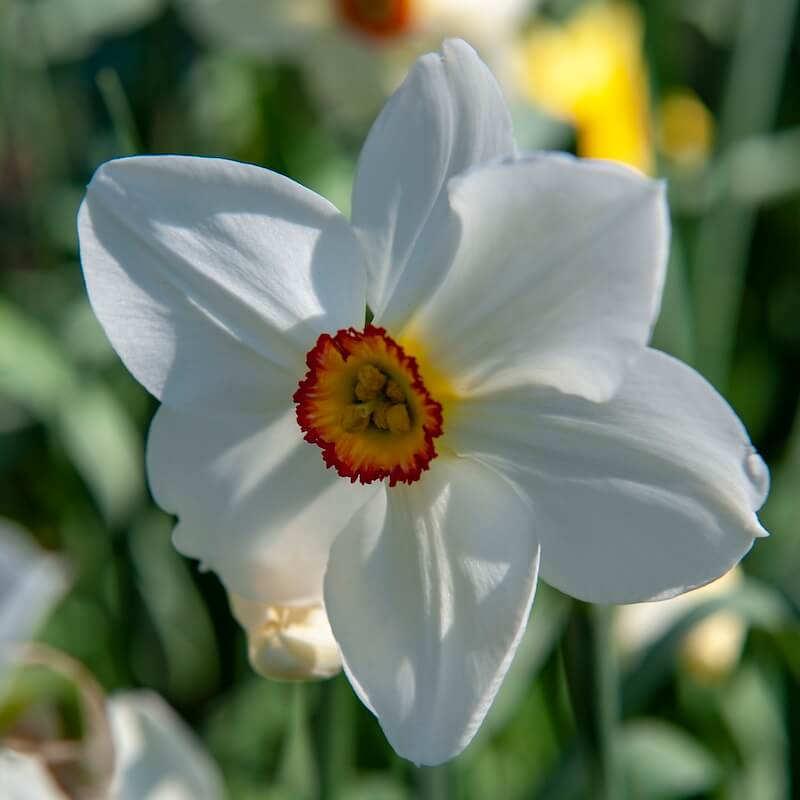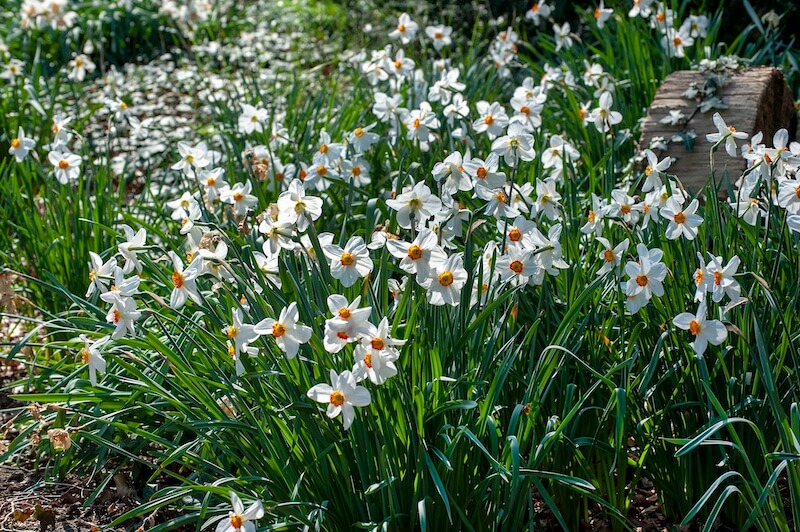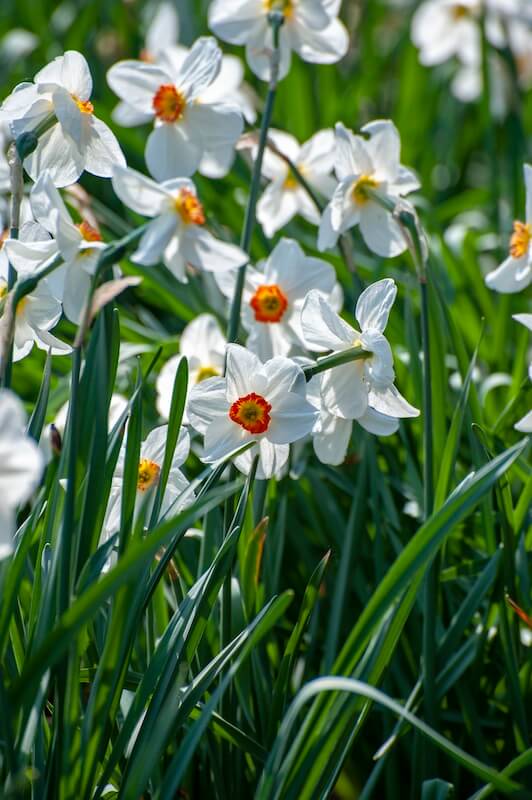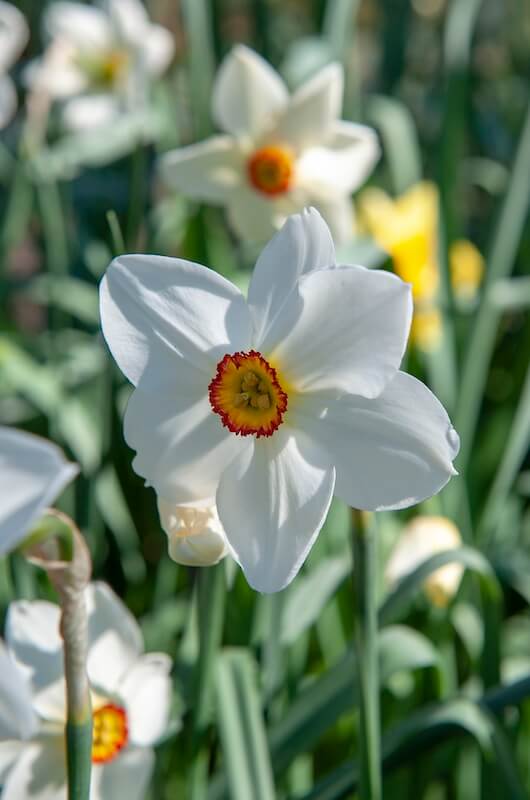
Position
- Full sun to light shade; full sun gives the best flowering and scent
- Prefers a sheltered spot protected from strong, drying winds
- Equally suited to borders, gravel beds, under deciduous trees or in large containers
Hardiness
- Tolerates winter lows down to around –20 °C (–4 °F)
- A light autumn mulch over the bulb bed aids establishment in very exposed gardens
Soil
- Tolerates winter lows down to around –20 °C (–4 °F)
- A light autumn mulch over the bulb bed aids establishment in very exposed gardens
- Adaptable to acid, neutral or alkaline soils
- Performs best where organic matter helps retain moisture without waterlogging
- Grab a soil test kit and ensure the perfect conditions for growth
Height
- Clumps establish over time, but individual stems remain about 35–40cm (14–16 inches)
Seasons of Interest
Additional Notes
- Plant bulbs in autumn, 10–12 cm deep and 7–10 cm apart, in drifts for best effect
- Leave foliage until entirely yellow before cutting back to allow bulbs to replenish their stores
- Divide and replant crowded clumps every 3–4 years once foliage has died down
- Dead-head spent flowers to keep the display tidy and channel energy back into the bulbs
- All parts are mildly toxic; wear gloves when handling and keep bulbs away from pets and children
- Excellent for naturalising in grass—lift and replace turf after flowering to avoid damage
Narcissus Pheasant's Eye - Fragrant Late-Spring Daffodils
Narcissus Pheasant’s Eye is one of the most graceful and fragrant daffodils you can grow in your garden. Known botanically as Narcissus poeticus var recurvus, this variety combines pure white petals, a tiny yellow cup edged with a red rim, and an unforgettable sweet scent. Often referred to as the poet’s daffodil, it carries a rich history alongside its natural beauty.
What Is Narcissus Pheasant's Eye and Why Is It Special?
Narcissus Pheasant’s Eye, also known as the old pheasant’s eye, is a late-flowering variety of daffodil. Unlike the bold trumpets of other daffodils, this one shows pure white petals surrounding a small yellow cup with a red rim. Its flowers carry a strong fragrance, making it an ideal addition to any spring garden.
The plant is part of the poeticus group, commonly referred to as poeticus narcissi. These varieties are celebrated for their refined flowers and sweet fragrance. The pheasant’s eye narcissus has also been awarded the Royal Horticultural Society’s Award of Garden Merit for its reliability and outstanding performance in the UK climate.
Its long history adds to its charm. Known since ancient times as a poet’s flower, narcissus poeticus has inspired writers, artists, and gardeners for centuries. Its combination of beauty, fragrance, and easy-to-grow nature continues to make it popular today.
How Does Narcissus Poeticus var Recurvus Differ From Other Daffodils?
Narcissus poeticus var recurvus is instantly recognisable by its reflexed, pure white petals and small yellow cup outlined in red. The recurved perianth gives the flower its distinctive swept-back look, unlike many other daffodils.
This variety is also one of the latest daffodils to flower. While many daffodils bloom in March or April, the pheasant’s eye usually blooms in May. This extends the daffodil season, adding colour and fragrance to your garden later in spring.
Another difference lies in its strong, sweet fragrance. While many daffodils have only a faint scent, the pheasant’s eye narcissus fills the air with perfume. This makes it especially valued as a cut flower, where its fragrance carries indoors.

When Should You Plant Bulbs of Narcissus Pheasant's Eye?
The ideal time for planting pheasant’s eye bulbs is autumn. Planting in this season allows the roots to establish before winter. By spring, your daffodils will be well-prepared to grow and bloom.
To plant the bulbs correctly, place each one at a depth two to three times the height of the bulb. This usually means around 10–15cm deep. Plant bulbs 10cm apart to give them enough room to develop without crowding.
Choosing the right spot in autumn is essential. Aim for a sunny or lightly shaded position with well-drained soil. With good preparation, your daffodil bulbs will produce strong, healthy flowers the following spring.
How to Prepare Soil for Planting Narcissus Bulbs
Narcissus bulbs thrive in fertile, well-drained soil. Poor drainage can cause bulbs to rot, so improving heavy soil with grit or compost is helpful. Loosening the ground before planting makes it easier for the roots to spread.
Add organic matter or a balanced fertiliser before planting to support healthy growth. This ensures bulbs have access to essential nutrients during the growing season. Good soil preparation at the start makes a big difference to long-term performance.
When you plant bulbs in borders, raised beds, or grass, always ensure water drains freely. A damp but not waterlogged environment helps them establish well and naturalise over time.

Where Is the Best Place to Grow Pheasant's Eye Daffodils?
Pheasant’s eye thrives in full sun but also tolerates partial shade. It is versatile, making it suitable for many garden settings. A spring garden filled with these flowers carries both fragrance and delicate beauty.
You can plant the bulbs in a border where the pure white petals stand out against green foliage. They also look stunning when naturalised in grass, where their slender foliage blends in effortlessly.
Growing them in a pot is another option. A cluster of pheasant’s eye narcissus in a container makes a striking display, especially placed by a doorway or patio where the fragrance can be enjoyed daily.
Why Is the Pheasant's Eye Narcissus Ideal for Naturalising?
Narcissus poeticus var recurvus is an excellent choice for naturalising. Once planted, these bulbs return every spring and often spread into larger clumps. Over time, they create an impressive drift of flowers in grass or wild areas.
Their grass-like foliage allows them to blend seamlessly into a meadow or lawn. Because they are perennial, they return year after year without much effort from the gardener. Simply plant the bulbs once and enjoy a growing display.
For the best effect, plant bulbs in groups rather than lines. Natural clumps look more relaxed and appealing, especially when the flowers appear among fresh green spring grass.
What Does the Flower Look Like Up Close?
Pheasant’s eye narcissus is striking when viewed closely. Each flower has pure white petals, a yellow eye edged with a red rim, and a reflexed perianth. This combination of colours makes it a standout in the garden.
The flowers are medium-sized, typically borne one per stem. Their graceful form and strong fragrance add a sense of refinement without being overpowering. They are equally suited to formal borders or naturalistic planting schemes.
The award of garden merit by the Royal Horticultural Society confirms the garden’s merit. Their appearance, coupled with fragrance, ensures they are a valuable addition to spring-flowering bulb collections.
How Fragrant Is Narcissus Poeticus?
Pheasant’s eye is among the most fragrant daffodils. Its sweet, strong fragrance fills the air, particularly noticeable on sunny days. Gardeners value it highly as a scented cut flower.
The scent is one reason narcissus poeticus is also grown commercially for perfume production. Its fragrance has long been admired, linking it with the romantic name of the poet’s daffodil.
Planted near paths, seating areas, or doors, the fragrance can be appreciated daily. A group of pheasant’s eye daffodils makes an excellent choice for adding scent to your spring garden.
How Do You Care for Pheasant's Eye Daffodils After Flowering?
Once flowering finishes, remove the faded blooms but keep the foliage intact. This allows the plant to continue photosynthesising and send energy back to the bulb.
Let the foliage die back naturally. Cutting leaves too soon prevents the bulb from storing enough energy for next year. By waiting until the foliage dies back, you ensure strong flowers in the following season.
Water sparingly after flowering and avoid overfeeding. These bulbs are easy to grow and require minimal care once established. A light dressing of fertiliser in spring is usually enough for healthy growth.
Can Pheasant's Eye Daffodils Be Grown in Pots?
Yes, pheasant’s eye daffodils can be grown successfully in a pot. Containers allow you to enjoy their flowers and fragrance close to the house.
Choose a pot with drainage holes and fill it with compost mixed with grit for better drainage—plant bulbs at the same depth and spacing as in the ground. Grouping several bulbs creates a concentrated display of pure white petals and red-rimmed cups.
Place the pot in full sun or partial shade. Regular watering is essential during growth, but avoid waterlogging. Once the foliage fades, you can leave the bulbs in the pot to naturalise or lift and replant in the garden.
Where Can You Buy Narcissus poeticus Bulbs?
Autumn is the best time to buy narcissus poeticus bulbs for planting. They are available in garden centres, nurseries, and from online bulb suppliers. Always look for bulbs that are firm, free from mould, and of good size.
Ordering early ensures the best choice, especially with popular varieties like Poeticus recurvus and Actaea. Large bulbs generally produce stronger stems and flowers, so select quality over quantity when you buy narcissus poeticus.
By choosing healthy bulbs, you give your plants the best start. With careful planting and the correct location, your pheasant’s eye narcissus will reward you with reliable flowers every spring.
From Darren’s Patch
Pheasant’s Eye narcissus has become a dependable favourite in my garden. I plant clumps in grass and at the front of borders, where their pure white blooms and red-rimmed cups catch the eye. The scent is the absolute joy — it drifts across the lawn on a cool May morning and brings people outside. I like them in pots too, placed by a back door so the fragrance meets you as you come in. They naturalise well, so once established, they reward you each spring with minimal fuss. I always leave the foliage to die back naturally; it feeds the bulbs for stronger flowers next year. For a simple, scented classic that adds late spring interest, this is one I happily recommend.
![]()
Key Points to Remember
- Plant the bulbs in autumn at two to three times their height
- Choose a sunny or lightly shaded spot with well-drained soil
- Pure white petals, a yellow cup, and a red rim give distinctive beauty
- Late-flowering, often blooming in May after other daffodils
- Strong fragrance makes it perfect for borders, pots, and cut flowers
- Leave the foliage to die back naturally after flowering
- Excellent for naturalising in grass and perennial in habit
- Awarded the RHS Award of Garden Merit for reliability and performance
- It is easy to grow and suitable for many garden settings
- The best time to buy narcissus bulbs is early autumn
Narcissus Pheasant’s Eye is a reliably hardy, fragrant spring bulb for UK gardens, flourishing in sun or light shade on well-drained, improved soils of any pH. Clumping to 35–40cm (14–16 inches) tall, it fills April–May borders with exquisite white and red-rimmed blooms, requiring only simple autumn planting and occasional lifting to maintain vigour.
Want to learn about other bulb varieties? Read about Narcissus Sweetness here.
For more information on Spring Flowering Bulbs for your garden, please click here.

Frequently Asked Questions
Q: What is Narcissus Pheasant’s Eye, and why is it special?
A: Narcissus Pheasant’s Eye is a poetic daffodil prized for its pure white petals and distinctive yellow eye with a red rim. Also known as pheasant’s eye or poet’s daffodil, it produces fragrant, late-flowering blooms that stand out in borders, naturalised grass, and spring gardens. The reflexed petals and strong perfume make it a favourite among gardeners who value traditional varieties. Easy to grow and reliable as a perennial, narcissus pheasant eye returns each year with minimal care, offering multiple fragrant flowers per stem. At the same time, its foliage feeds the bulb for a healthy display the following spring.
Q: When and how should I plant Narcissus Pheasant’s Eye bulbs?
A: Plant bulbs in autumn, ideally in well-drained soil at a depth of about two to three times the bulb’s height. Space them approximately 10–15cm apart to allow healthy development and naturalisation. Choose full sun or light shade, as this daffodil thrives in bright conditions. For pots, ensure free-draining compost to avoid waterlogging. Planting early allows roots to establish before frost, helping narcissus pheasant eye withstand winter temperatures around -5 °C to -15 °C (23 °F to 5 °F)—plant bulbs with the pointed end facing upwards for optimal growth and a strong spring flowering display.
Q: How do I care for Narcissus Pheasant’s Eye after flowering?
A: After flowering, deadhead spent blooms to keep displays tidy and prevent energy from being diverted to seed production. Leave foliage to die back naturally, allowing leaves to photosynthesise and feed the bulb. A light feed of balanced fertiliser after flowering strengthens bulbs and supports next year’s flowers. Avoid cutting the foliage too early. Narcissus Pheasant Eye is low-maintenance, but consistent care ensures robust blooms and healthy foliage year after year. Naturalising the bulbs in grass or borders will reward gardeners with reliable, fragrant flowers for seasons to come, enhancing the spring garden.
Q: Can Narcissus Pheasant’s Eye be grown in pots or containers?
A: Yes, Narcissus Pheasant’s Eye thrives in pots or containers, making it ideal for patios, balconies, and smaller gardens. Use a free-draining compost and plant bulbs at the recommended depth, spacing them two to three times their width apart. Place containers in full sun or light shade to promote vigorous growth and flowering. Multiple bulbs in one pot create a dramatic display of white petals with yellow eyes, while the fragrance fills the surrounding area. After flowering, allow foliage to die back naturally, and lightly feed the bulbs to ensure a reliable spring bloom the following year.
Q: What are the ideal growing conditions for Narcissus Pheasant’s Eye?
A: Narcissus Pheasant’s Eye prefers well-drained soil that remains moist in spring but avoids waterlogging, which can cause bulb rot. Full sun encourages strong stems and prolific flowering, though it tolerates light shade. The perennial thrives in borders, naturalised grass, or containers, producing multiple flowers per stem. Planting in autumn allows roots to establish before winter temperatures reach -5 °C to -15 °C (23 °F to 5 °F). Regularly feed bulbs after foliage dies back to strengthen the next season’s display. Its late-flowering habit extends spring colour and fragrance when many other daffodils have finished.
Q: How can I naturalise Narcissus Pheasant’s Eye in my garden?
A: To naturalise pheasant eye narcissus, plant bulbs in groups of odd numbers within grass or borders. Choose well-drained soil and allow foliage to die back naturally each year. Over time, the bulbs will spread, creating drifts of fragrant white flowers with yellow eyes and red rims. Avoid disturbing naturalised areas, and lightly feed bulbs in autumn to support strong growth. Narcissus Pheasant Eye combines well with other spring-flowering bulbs, offering a prolonged bloom season. Its perennial nature ensures dependable displays year after year, creating a traditional and charming spring garden without extensive maintenance.
Q: Can Narcissus Pheasant’s Eye be used as a cut flower?
A: Yes, the fragrant blooms of Narcissus Pheasant’s Eye make excellent cut flowers. Cut stems early in the morning when flowers are fresh, and place them in clean water immediately. Its pure white petals with a yellow eye and red rim add elegance to floral arrangements, while the scent fills the room. Avoid mixing with other flowers in the same vase until the first hour has passed, as narcissus sap can affect other blooms. After cutting, maintain the remaining bulbs in the garden, allowing foliage to die back naturally to replenish reserves for next spring’s strong and reliable display.
Q: How tall does Narcissus Pheasant’s Eye grow?
A: Narcissus Pheasant’s Eye typically reaches around 35–40cm (14–16 inches) in height, making it a medium-tall daffodil suitable for borders, naturalised areas, and containers. The stems are strong enough to support multiple fragrant flowers, even in breezy conditions. Its height allows it to combine beautifully with early spring flowering bulbs like tulips and crocuses, creating layered displays. The foliage is narrow and grass-like, blending seamlessly into the garden. Proper planting depth and soil preparation enhance stem strength and overall flower performance, ensuring the pheasant eye daffodil makes a reliable and visually striking contribution to the spring garden.
Q: Are Narcissus Pheasant’s Eye bulbs readily available to buy?
A: Yes, you can buy Narcissus Pheasant’s Eye bulbs at garden centres and through online suppliers across the UK. Look for firm, healthy bulbs free from mould or damage to ensure strong growth and reliable flowering. Popular varieties, including narcissus poeticus var and poeticus recurvus, are often offered individually or as part of spring flowering bulb collections. Buying in autumn provides the best selection, allowing you to plant at the ideal time for root establishment before winter. High-quality bulbs guarantee robust stems, multiple fragrant flowers per stem, and long-term enjoyment in your garden year after year.
